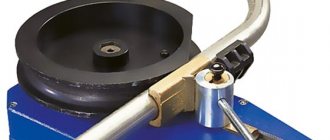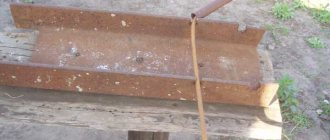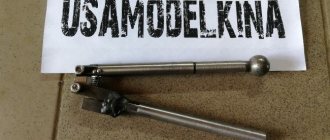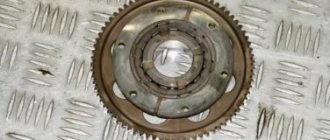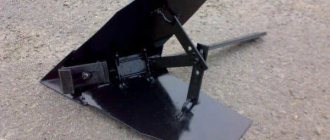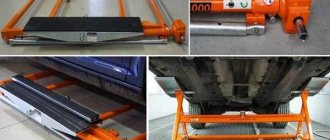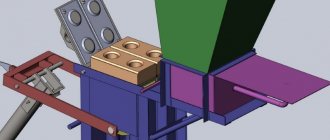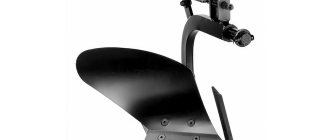Application of bent pipes
You can bend a profile pipe using a special device - a manual pipe bender. By performing this procedure, you can obtain good quality products that are used in many areas of our lives.
Bent profile pipes are used for the manufacture of building structures, arches, greenhouses, fences, and gates. They are a decoration for elegant outdoor furniture: benches, chairs, tables. Bent profile and round metal pipes are used for the production of school desks, chairs, furniture for medicine, offices, and other institutions.
Do-it-yourself manual pipe bender for profile pipes
*
To bend a profile pipe with small cross-sectional dimensions without a pipe bender, craftsmen use templates of the desired curvature made of metal or wood. The workpiece is pressed manually to the edges of the segment, rigidly fixing one end.
Wood template
The thin-walled element can be deformed when heated. Heat the area with a blowtorch to a temperature of 350-400°C and, using manual force, give the profile an arched shape.
If using simple methods is not allowed by the product parameters, you can design a manual roller pipe bender for a profile pipe. It is used to make arches and arcs for canopies, greenhouses and other structures of complex shape.
Required materials and tools
To make the device, you will need:
- channel No. 8 or No. 10 for a rigid frame;
- 2 hardened steel rollers with steps for profiles of different heights or restrictive rings;
- roller with notches for the movable shaft;
- finished bearing units;
- 2 or 3 gears or sprockets;
- steel chain;
- clamping screw;
- thin pipe for the gate;
- lever;
- welding machine;
- drill;
- "Bulgarian";
- hammer.
You also need cotter pins, nuts, threaded bushings, and washers. To process the finished structure you will need paint and lubricant.
Blueprints
The drawing is the basis that will help you make a pipe bender without making major mistakes. This is especially important when working with metal labor-intensively.
Ready-made drawings are available on the Internet. Having sufficient experience, they are easy to understand and adapt to your capabilities.
You can imagine an approximate structure of a pipe bender by studying a factory analogue, and then develop a detailed diagram of your model.
Drawing and general view of a hand tool
*
Construction assembly stages
Sequence of operations for making a homemade roller pipe bender:
- Cut the channel to the dimensions of the posts and base.
- Drill holes in the frame parts to mount the rollers.
- Weld a support frame with racks from a channel.
- Cut and weld a housing from the channel with holes for installing the drive roller. The shaft should rotate easily inside.
- Secure the clamping screw to the resulting box using bearings. Drill a hole in the top of the screw for the collar.
- Insert the housing with the drive roller between the posts. The structure must move freely vertically. Secure the cover with a screw nut on top.
Clamping mechanism diagram - Screw the bearing units to the frame.
- Insert the collar into the hole in the clamping bolt.
- On the outside of the shaft axis, place the gears on a key or split cone bushings with nuts. Attach the third “star” to the stand. Put on the chain and press in the sleeve for the handle.
- Conduct trial tests and make adjustments if necessary.
The last step is to disassemble, clean the metal from burrs, paint the fixed parts, and reassemble. Units that are subject to friction during operation should be treated with Lithol or other thick lubricant.
Ready homemade machine
To bend the workpiece, it is placed on stationary rollers, the pressure screw is lowered all the way and pulled using a rotating handle alternately in one direction and the other.
After each rental, the screw is tightened with a collar. When the arc acquires sufficient curvature, the screw nut is secured with a lock nut. This will allow you to bend several arches with the same radius.
This homemade pipe bender can even be used for professional purposes. It can handle profiles up to 60x60 mm in size or 3 pipes with a cross-sectional width of 20 mm at the same time.
Details of the handloom manufacturing process can be seen here
Features of hydraulic pipe benders
A hydraulic pipe bender, made by yourself according to your own sketches or drawings, or taken from the Internet, is a special device that can be used to bend pipes or rolled products at different bending angles, ranging from 0 to 180⁰.
You can buy a good hydraulic pipe bender in stores, or you can try to make it yourself, which in terms of quality of operation will be in no way inferior to factory products.
And since improvised means and materials are used for self-production, the cost of such a bending structure will be much cheaper than serial devices. And the financial side of the manufacture of such a device, you see, is of great importance for most of us. Taking this into account, many craftsmen make universal structures with their own hands, with the help of which profile and round pipes with any bend radius can be easily and efficiently bent. And the Internet helps them, where you can choose not only the hydraulic pipe bender you like to make with your own hands, but also watch ready-made drawings, videos, listen to or read advice from experienced craftsmen.
Among factory analogues, the Stalex hydraulic manual pipe bender is very popular, with the help of which metal-plastic pipes and metal products can easily be bent. It is convenient for professionals to work with such a tool, since pipes can be bent directly on the construction site, and very smoothly and accurately. The design of a mass-produced manual pipe bender is such that when using it, flattening or breaking is completely eliminated.
Peculiarities:
- creates a force equal to 12 tons;
- equipped with a hydraulic drive;
- equipped with a set of replaceable shoes;
- can operate in horizontal or vertical position;
- provided with automatic return of the slider;
- during operation, the entire stroke of the cylinder is involved;
- The bending radius is adjusted by vertical or horizontal supports (depending on the model).
Types of pipe benders with hydraulics
All existing hydraulic pipe benders can be divided into designs:
- manual;
- automatic.
Based on their size and installation method, they are divided into mobile and stationary.
Manual systems include a tool that generates the force thrust of the actuator using the user’s muscular energy. Figuratively, this version of the tool looks simple: the design contains a hydraulic cylinder pump handle, which must be manually actuated.
The standard design of a pipe bender is equipped with a hydraulic cylinder. Many manual models from different manufacturers are designed according to this principle.
Automatic systems exclude the use of manual force, but they also do not show any special difficulties of mechanization. The pump handle on the hydraulic cylinder is simply replaced by an electric drive. On such a pipe bender, the reciprocating movements of the pump rod are driven by an electric motor.
Modified hand model of a pipe bending tool. Instead of a lever for manual action, a small-sized electric motor of low power is used here
Mobile structures include both manual and automated tools. As a rule, these devices are lightweight, compact, and easy to transport. But the mobility and compactness of the devices somewhat limits their technical characteristics.
The mobile tool is distinguished by its small overall dimensions, relatively light weight, and the ability to connect to a household electrical outlet. However, there are limitations on technical parameters
Stationary pipe benders are also available in manual (lever) designs or equipped with an electric drive (often three-phase). Here we can already see quite large, powerful equipment designed for bending strong, durable products.
Stationary hydraulic pipe benders are powerful systems capable of bending large diameter pipes. Typically used for industrial production needs
Stationary structures are rigidly installed in one place without the possibility of their rapid transfer.
Advantages
Among the many manual pipe benders, hydraulic type machines are considered the most popular and in demand. There are good reasons for this.
Hydraulic devices are capable of efficiently bending even a 3-inch round pipe. They are successfully used both by professionals to perform large volumes of work, and by novice amateurs who want to bend one or two profile or round pipes.
In addition to such advantages as:
- ease of manufacture;
- reliability;
- strength;
- low cost,
They are also valued for their impact power, thanks to which they can process not only thick-walled steel pipes, but also work with fairly large products made from other metals: aluminum, copper, brass, bronze.
In addition, a special installation (jack) greatly facilitates the work of the operator, who makes a minimum of effort to obtain a large force of pressure on steel or other materials pipes.
Important! You cannot bend the pipe more than is provided for by the design of such a device, although there may be opportunities for this. This is due to possible invisible damage to the finished part, which will certainly appear a little later, during operation.
Main advantages of hydraulic manual pipe benders
A hydraulic pipe bender bends pipes using high pressure at one (manual machines) or several points (electric models). The most common type of device is a hydraulic crossbow pipe bender.
Hydraulic hand-held devices have many advantages compared to other types. Their main advantages include:
- compactness;
- cheapness;
- reliability;
- ease of use;
- mobility;
- accuracy;
- high bending speed;
- no additional energy costs.
Hydraulically driven pipe benders, unlike conventional manual devices, have higher efficiency and can perform fairly large volumes of work. In addition, they are not stationary, which allows them to be used in the right place. Due to the fact that the design of such a device is much simpler than that of its electrical counterparts, they are much less likely to break down. This is also a huge plus.
Preparation for production
Before making a manual pipe bender, you need to decide on the type of device. To do this, you need to familiarize yourself with the drawings and photos, as well as diagrams of possible designs made by yourself, watch a video, remember what materials and available tools you have, and only then begin the manufacturing process. And most importantly: for what purpose and for what work will you need a structure with which you can bend the risers. Plus, it would be a good idea to consult with a more experienced neighbor or friend who has already dealt with the manufacture of this or a similar device. And if you are ready, then you can start making a device for bending profiles.
Operating principle of the equipment
The main elements of the device should be considered:
- hydraulic cylinder;
- support shoes.
A hydraulic cylinder is a power unit that facilitates bending and allows products to be shaped with the least effort.
Operating principle of a hydraulic pipe bender
Its presence is the main design difference between a hydraulic profile bender and other types of devices.
Support shoes are removable elements selected in accordance with the diameter of the workpiece. They are crescent shaped and are necessary for reliable fixation of the pipe using metal pins.
When moving, the hydraulic cylinder moves the support shoe with the pipe until it stops while the pins hold the product. This achieves an even bend in the center. Some bending shoes have markings to better identify the center of the bend and an angle to help the user determine cylinder pressure.
Manufacturing process
Before you start making a machine for bending a round pipe, you need to stock up on everything you need:
- a hydraulic jack from a car or tractor (more powerful ones can be used, if possible);
- shoe (punch);
- channel (about 3 meters);
- 3 rollers with axes;
- metal plates.
When making a manual pipe bender, you should follow a simple algorithm:
- Using a tape measure, measure the required length of the channel for the base and use a grinder to saw off 2 equal pieces, thanks to which the base of the future hydraulic pipe bender, and with it the frame (1), will be more stable.
- Place the cut pieces of the channel tightly to each other, weld from below and from above along the joint line. Such a platform will be the basis of a pipe bending machine.
- Weld side channels on both sides of the base at an angle of 110⁰.
- Weld longer pieces to the top of the side channels, in which it is first necessary to drill several (from 2 to
 holes placed symmetrically on both sides of the future pipe bending machine. They are intended for installing axles with pressure rollers in them, by rearranging which it will be possible to adjust the radius bending of risers.
holes placed symmetrically on both sides of the future pipe bending machine. They are intended for installing axles with pressure rollers in them, by rearranging which it will be possible to adjust the radius bending of risers. - Secure the jack (3) to the base with plates with holes for bolts (2) with a diameter of 10-12 mm so that it does not move when working with steel or other pipes. To do this, you need to drill the base in certain places and secure the hydraulic device with strips and bolts.
- Securely fasten the shoe (4) to the jack rod so that, if necessary, it can be easily removed and replaced with another one.
Scheme for making a manual pipe bender
That's it, the design is ready for work, and the required dimensions are indicated in the drawing of a pipe bender made by yourself, although in the photo, no holes are drilled in the upper channels (there are 2 of them, one on each side of the side channels). Therefore, the manual hydraulic pipe bender shown is designed to bend parts with only one bend radius.
The height of the bending machine is determined by the parameters of the jack and the distance “a”. This means that to bend a half-inch steel pipe, this length should be approximately 2 cm (if the jack is not in use).
It should be noted that all the force from the punch is directed to the upper part of the manual pipe bender. Therefore, there may be cases where the outer part of the bending part is subjected to too much stretch, which will contribute to a significant thinning of the wall of the round pipe. There are even tears in the riser. Therefore, it is not always possible to use the unit to bend thin-walled pipes.
As you can see, there is nothing complicated, and the design for bending a round pipe is reliable, durable and will last for decades. And most importantly, only available materials were used for its manufacture, which greatly reduced the cost of such a device.
Advantages and disadvantages of equipment
Hydraulic profile benders of manual and mechanical type are often found in production and at home among people who regularly deal with bending metal profiles and pipes. This is due to a number of advantages inherent in the devices. These include:
- A large volume of work that a pipe bender can perform without interruption.
- The ability to select a tool based on the specifics of the job and ensuring convenience (some users need pipes to bend horizontally, while others need a vertical pipe bender).
- The ability to change punches (elements for bending at a certain angle) if you need to achieve greater bending of the workpiece.
- Almost complete absence of deformation of parts when using a hydraulic drive.
- Facilitation of installation of water supply systems by reducing the number of fittings and bends.
- Some pipe benders bend several pieces at once, optimizing production processes.
- Working with a manual or electric pipe bender is not particularly difficult even for a beginner.
- Most stationary hydraulic profile benders are equipped with a frame that protects the worker from injury and prevents the pipe from suddenly slipping out.
- Possibility of repairing some components with your own hands.
The models have few disadvantages, but still not without them. For example, most manual pipe benders only come with one 90-degree bending punch, forcing the user to spend extra money if they need a different angle. The second disadvantage, already related to electrical devices, is high energy consumption. The third is the high cost of stationary models. Fourth is the need to carefully care for the equipment to ensure maximum service life. Now let's talk about common equipment problems.
Rolling version of a pipe bender with a rotating platform
The device is used for profile pipes. The principle of operation of this design is as follows: the rotary platform, driven by a jack and through which the bending angle is set, is connected to the main frame using a hinge. The profile is pulled as a result of rotation of the handle, which is attached to the intermediate shaft of the bending machine.
Bending machine
The base for a manual pipe bender and the stand are made of channels with a wall height of 125-200 mm. Bearing cages, the basis of the rollers, can be made from a steel pipe, and its diameter must match the diameter of the bearings.
The bending parameters can be adjusted in two ways: using a turntable and using rollers located on the edge.
For this purpose, it is necessary to drill the support plates and channel, which will ensure the mobility of the elements of the bending machine.
Both platforms of such a device are also made of channels. To raise the outer platform of a manual pipe bender, use a conventional automobile or tractor hydraulic jack.
To weld a vertical stand from a channel, it is necessary to retreat approximately 45-50 cm from the edge of one side of the base of the hydraulic pipe bender. To strengthen it, it is advisable to pair two pieces.
Using a building level, it is necessary to achieve strict horizontality of the stationary platform of a homemade bending machine, and then weld a stand to the back of it. Using profile pieces, build up the limiters to a height at least equal to or greater than the thickness of the profile or round pipes that will be bendable.
Using the door hinges, connect the main frame of the manual pipe bender to the guide platform. Mount bearings on the edges of moving and stationary platforms, as well as on the limiters of such a device, using welding.
To strengthen the entire structure of the hydraulic pipe bender, it is necessary to use corners that are welded in separate places. Attach a handle to the middle shaft of the bending machine, and install bearings on the outer ones.
Place the jack from below under the guide platform, securely fasten it to the base using bolts, and the homemade pipe bender is ready for work.
By the way, you can also do the repair of a hydraulic pipe bender made by yourself, and here’s why: no one except you knows the features of its structure and operating principle. Therefore, only you yourself can make high-quality pipe bender repairs at home.
Tips for using a hydraulic pipe bender
One of the most common problems that arise when operating hydraulic equipment is air getting into the system. At the same time, the developed force decreases in the design, as a result of which the pipe bender handle begins to spring.
Repairing hydraulic pipe benders in this case is quite simple. To correct this problem, it is advised to screw the screw of the pipe bender all the way and remove the axle that connects the handle to the plunger. Then you need to remove the plunger and pour oil into the special hole in the sleeve. Next, the structure is put back together and the handle is pumped. 10 movements are enough to pump.
A fairly common problem when using hydraulic pipe benders is the static nature of the rod element. If it does not move during operation of the device, then you need to check whether the suction check valve is working properly. It is recommended to carry out repairs as follows: tighten the screw and lift the handle of the device until it stops. Next you need to hit it so that it goes down. If necessary, you can repeat this procedure several times.
Important! Hydraulic pipe benders require periodic inspections. This rule especially applies to electrical devices, the parts of which wear out over time. Worn parts must be periodically replaced with new ones. If repairs are not carried out on time, then this is fraught with big problems.
And finally, breakdowns of the electric drive in electric pipe benders very often occur. In this case, it is recommended to call a specialist who understands such issues and can carry out high-quality and competent repairs of the bending device.
To make a pipe bender with your own hands, a regular hydraulic jack is suitable
Bending technology
The bending process looks like this: first you need to install the steel pipe into the shoe and secure it on both sides. After this, you need to use a jack, thanks to which such a device (rod together with the shoe) will rise up. The force created by the hydraulic drive is instantly transferred to the rollers, after which the riser will begin to bend under the preset bending radius. After finishing the bending process, the device must be lowered and the finished product pulled out. The main thing is that such a bending machine can be stopped at any time, which eliminates the possibility of injury.
Important! If it is necessary to bend a very short profile pipe, and the distance between the rollers does not allow this, then it is necessary to extend both ends of the riser with scraps of pipes of the appropriate diameter.
Hydraulic frame vertical models
Portable equipment for installation of heating and water supply systems, during the construction phase and during facility maintenance. The heaviest models can also cope with gas pipes, but operation at the limit of capabilities for such a tool is disastrous - the hydraulic cylinder seals are damaged. The most inexpensive devices should be chosen carefully - there may be problems with the paint coating, there are parts that have not been processed after casting, and an unpolished rod has been noticed more than once.
Stels 18115 — from 7,500 rubles
A portable device for bending water pipes at an angle, according to a template. It is cheap and repairable, so it is popular among those who independently install communications in their own home. There is a spring return of the rod to its original position, and a plastic suitcase for storing the entire set of equipment. A modest set of bending stops and not the most reliable hydraulics exclude the possibility of commercial operation of this model.
Please note: the vertical position is the optimal position for operating the device.
By placing it horizontally (there is an opinion that it is more convenient to swing the lever this way), you will hold the pipe suspended until it is clamped between the template and the shafts. Technical characteristics of Stels 18115
| Characteristic | Meaning |
| Workpiece dimensions, inch | ½, ¼, 1 |
| Maximum bending angle, degrees | 90 |
| Hydraulic cylinder force, kPa | 8 |
| Weight, kg | 25 |
| Equipment | 2 or 3 templates, plastic suitcase |
Stels review from an official dealer:
Matrix 181335 - from 11,309 rubles
A budget tool capable of bending pipes with a wall thickness of up to 3.5 mm. Rotating supports reduce the risk of scratching the surface of the workpiece, which is important when working with copper pipes in a plastic sheath. There are springs that return the rod to its original position after releasing the pressure.
Minus - the “original” hydraulic cylinder seals begin to leak oil when working with the maximum permissible dimensions of the workpiece (can be treated by simply replacing the seals). A paradoxical feature of this model has also been noticed - there are special supports on the frame, but the manufacturer does not allow working in a horizontal position.
Keep in mind that there are no complaints about the functionality of the templates, but if they fall on a concrete floor, they may burst.
They are not sold in retail stores; you can only buy them through a service center.
Technical characteristics of Matrix 181335
| Characteristic | Meaning |
| Workpiece dimensions, inch | ½, ¾, 1, 1¼, 1½, 2ʺ |
| Maximum bending angle, degrees | 90 |
| Hydraulic cylinder force, kPa | 12 |
| Weight, kg | 32 |
| Equipment | 6 templates |
Private review of Matrix 181335:
Methods for bending pipes with a hydraulic machine
Before bending a profile or round pipe, it is advisable to listen to the advice of people experienced in this matter.
Firstly, homemade hydraulic pipe benders bend pipes made from any materials quite efficiently. It is very important that with the help of the device thick-walled products are bent without any kind of defects, which is beyond the capabilities of pipe benders of other structures made independently at home.
Secondly, the procedure can be carried out using hot and cold methods, which also makes such devices more popular and in demand.
The highlight of cold bending is that a steel or other metal pipe must be filled with something before performing the operation. Sand, salt, oil or oil refinery, and water are well suited for this. Thanks to such fillers, the quality of bending of steel pipes or products made of other metals is significantly improved, and the occurrence of all kinds of unnecessary deformations is eliminated.
With the hot method, you need to preheat a certain section of the steel pipe, and then bend it in the same way as a cold workpiece, but without filler.
Thirdly, to obtain a high-quality product, thick-walled structures are bent using a homemade hydraulic pipe bender using the hot bending method.
Operating principle of a pipe bender
The pipe bending machine is designed for bending pipes at an angle of up to 90°. This processing of a rigid all-metal element allows you to avoid welding pipes and creating threaded connections.
When bending, the principle of mechanical cold deformation is used. The material is not adversely affected by high temperatures. The rolled metal is placed between the static rollers of the device, and the movable pressure shaft creates a force that bends the profile at the desired angle.
Operating principle of a roller pipe bender
To avoid deterioration of technical characteristics and metal destruction, the bending radius of the pipe is limited.
Its minimum value depends on the type of material - steel, copper, aluminum - and wall thickness. In this case, the thinning of the section does not exceed 20-25%. As a result of plastic deformation, the profile acquires a curved shape without loss of strength.
Table of minimum radii for bending steel profiles
*
To obtain a section of the angular configuration, use the local impact tool. The force is applied pointwise. The bend is formed by extrusion.
The profile bender differs from a conventional pipe bender for round pipes because it is designed to deform a profile that is more resistant to bending loads. To make arcs or arches, the workpiece is pulled on a rolling machine with one or more rollers and a large bending radius.
Instructions for making a pipe bender
Making a pipe bender for a profile pipe yourself is not at all difficult if you adhere to the following technological sequence.
- Gears, bearings and rings are placed on the pressure shaft, which are connected to it using a key. First, a drawing of such a shaft, races for bearings and rollers is developed, then these parts are turned, which is best entrusted to a qualified turner. In total, for this device it is necessary to make three shafts, one of which is suspended on springs, and the other two are located on the sides.
- Then it is necessary to drill holes in the rings, which are necessary for making grooves and threading.
- Now you need to make a shelf, for which you use a channel, in which you also drill holes and cut the threads required when installing the pressure shaft.
- After completing the preparatory measures, the entire structure of the equipment must be assembled, for which welding and bolted connections are used. First of all, the frame is installed, which also serves as the legs of the pipe bender.
- The next step is to hang the shelf with the pressure shaft attached to it, for which springs are used. After this, you need to install side support shafts on the homemade pipe bender, on one of which a handle is attached.
- The final touch is to install the jack on the pipe bender.
Making a simple template-type pipe bender
A simple rolling pipe bending machine can even be made from wood. Naturally, this will be a manual pipe bender, the design of which may not even include a pressure roller if it is used for thin-walled products. The template for such a device is made from a wooden board, the thickness of which should be such that it exceeds the diameter of the pipe itself.
Wooden template for a simple manual pipe bender
For ease of work, it makes sense to consider profiling the template from its end in order to avoid the pipe jumping off during bending. For these purposes, you can fold two boards, first sawing one edge at a time, thus creating a kind of gutter. A pre-drawn drawing will help avoid mistakes.
When using such a pipe bender, the template is attached to a reliable base, and a stop is attached to the left side of it (for right-handers). The pipe that needs to be bent to the required radius is placed between the template and the stop and carefully bent, making sure that it does not jump off the template.
Collapsible hook template
With the help of such a pipe bender, made from scrap materials, you can bend along a large bend radius. You can avoid making a wooden template and simplify the device by replacing it with metal hooks fixed to the base, located in a circle with the required bend radius. This device is convenient in that the dimensions of the bend can be changed at any time by placing the stop hooks around a circle with a different radius.
Armed with a manual winch, you can significantly expand the range of work performed due to a noticeable increase in traction force for bending pipes.
The winch will help expand the functionality of the simplest manual pipe bender
